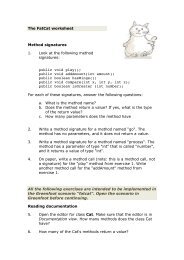SCIENCE TEST
SCIENCE TEST
SCIENCE TEST
You also want an ePaper? Increase the reach of your titles
YUMPU automatically turns print PDFs into web optimized ePapers that Google loves.
The word tared is italicized and defined in the description of Experiment 1. This is a clue<br />
that it will be used in one of the questions (we saw the same thing with the word<br />
refracted in Passage I). The definition given for tared is “the balance was reset to 0.000<br />
g)”. Why would the students reset the balance to 0 after the graduated cylinder was<br />
placed on it? Because they are interested in the weight of the liquid added to the cylinder,<br />
not the weight of the liquid plus the weight of the cylinder.<br />
27. A student claimed that polycarbonate is more dense than PA-6. Do the results of Experiments 1−3<br />
support his claim?<br />
A. No, because in Liquid 8, polycarbonate stayed at the bottom and PA-6 rose.<br />
B. Yes, because in Liquid 8, polycarbonate stayed at the bottom and PA-6 rose.<br />
C. No, because in Liquid 8, polycarbonate rose and PA-6 stayed at the bottom.<br />
D. Yes, because in Liquid 8, polycarbonate rose and PA-6 stayed at the bottom.<br />
4<br />
Answer: B.<br />
From Table 3, we see Passage that polycarbonate VI and PA-6 are both plastics used to make Experiment beads 2<br />
for Experiment 3. If polycarbonate sinks in a particular liquid and PA-6 rises in that Synergism occurs when 2<br />
Bacteria break down sugars by fermentation. To study<br />
liquid, then polycarbonate is more dense that PA-6. This is exactly what happens together for to ferment a sugar by using<br />
2 fermentation pathways, researchers performed 2 experi-<br />
species can use alone. To investiga<br />
liquid 8.<br />
ments using broth that contained either the sugar sucrose or ment 1 was repeated, except that diff<br />
the sugar lactose. One of the fermentation pathways pro- species were added to each large test<br />
duces CO2 gas and increases the acidity (lowers the pH) of<br />
Passage VI the solution. The other pathway produces acid but not CO2. Bacteria break down sugars by fermentation. To study 2 fermentation pathways, researchers performed 2<br />
experiments using broth that contained either the sugar sucrose or the sugar lactose. One of the<br />
Table 2<br />
fermentation pathways produces CO2 gas and increases the acidity (lowers the pH) of the solution. The<br />
other pathway produces acid but not CO2. Experiment 1<br />
Sucrose broth<br />
Species<br />
Experiment 1<br />
Sucrose broth was added to 5 large test tubes. Next,<br />
added acid CO2 Sucrose broth was added phenol to 5 large red (a test pH tubes. indicator Next, phenol that is red yellow (a pH if indicator pH < 7, that red is ifyellow<br />
if pH < 7, red<br />
pH ≥ 7) was added to each large test tube. A Durham tube<br />
A and B − −<br />
if pH ≥ 7) was added to<br />
(a<br />
each<br />
small<br />
large<br />
test<br />
test<br />
tube)<br />
tube.<br />
was<br />
A Durham<br />
placed,<br />
tube<br />
inverted,<br />
(a small<br />
in<br />
test<br />
each<br />
tube)<br />
large<br />
was<br />
test<br />
placed, inverted, in<br />
A and C + +<br />
each large test tube to collect tube to CO collect 2 (see CO Figure 1). 2 (see Figure 1).<br />
B and D + +<br />
C and D + +<br />
Durham<br />
tube<br />
broth<br />
(red)<br />
Figure 1<br />
The large test tubes were capped, The large heated test until tubes the solutions were capped, were sterile, heated then until cooled. theOne<br />
of 4 bacterial<br />
species (Species A−D) solutions was added were to each sterile, of 4 of then the large cooled. test tubes. One The of 4 procedure bacterial was repeated using<br />
lactose broth instead of species sucrose (Species broth. The A−D) 10 large was test added tubes to (all each containing of 4 of the solutions large at a pH of 7) were<br />
then incubated at 37°C<br />
test<br />
for 48<br />
tubes.<br />
hr.<br />
The procedure was repeated using lactose broth<br />
instead of sucrose broth. The 10 large test tubes (all containing<br />
solutions at a pH of 7) were then incubated at 37°C<br />
for 48 hr.<br />
28. In Experiment 1, which of the<br />
The large test tubes and Durham tubes were exam- mented lactose?<br />
ined. If acid was produced, the solution was yellow. If no F. Species B only<br />
acid was produced, the solution remained red. If CO2 was G. Species C only<br />
produced, a gas bubble was observed at the top of the H. Species B and Species D on<br />
Durham tube (see Table 1).<br />
J. Species C and Species D on<br />
29. Suppose that in Experiment 2



